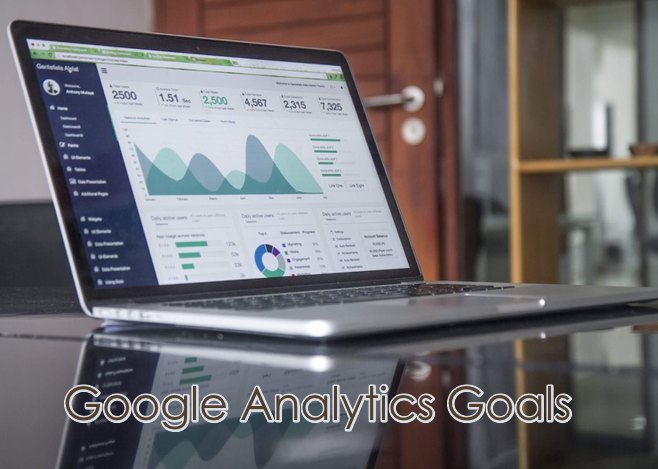05 Dec

|
Getting your Trinity Audio player ready...
|
Google Analytics Goals: Every website developer wants their website to be recognized, and to grow by leaps and bounds. A growing website is a symbol of growth and prosperity for the creator, whether they are an entrepreneur, a large company, or regular blogger seeking to share their views with the world.
And in order to grow, the content needs to be optimized according to the tastes of the viewers. And that is why they need the help of these analytic services.
Table of Contents
What is google analytics?
It is one of the most popular and useful tools that is maintained by Google. It is used by nearly all websites, in order to get information regarding the type of traffic their site receives.
As the name suggests, this tool provides an in-depth analysis of every type of traffic for more than 50 million websites. It provides you with statistical data for every type of traffic.
How does google analytics work?
Basically, analytics monitors and tracks all types of web traffic that comes to your web platform. This allows it to get an overview of the different qualities and aspects of the type of people who are visiting your site.
And once you are aware of the people who are looking at your content, it will be easier for you to put up information that appeals to them.
Analytics tells you about the signups for your site, subscriptions you have received, downloads of your content, views, and other leads for marketing. These things are called metrics.
A metric is a measure. In this case, it is a measure of the growth of your site. However, in order to do that, you need to add google analytics to your website. And that is our main topic today. In order to look at that, we need to be aware of a few things.
Google does not automatically track your performance. It requires some additional information, and effort from your side.
Let’s get started, shall we?
Set up your Google Analytics goals.
This is the first step. Google needs to know how you are going to let it track your business. Basically, Google can track goals through the site’s URL, time spent on the site, the number of visits on the site, and the events on it.
So, you need to go to the Google analytics standards reports. Go there and click on the Admin button, located in the top right corner of the site. Select “goals”, and look at the set of goals provided to you.
Name your goal. This is important, as it will be used by the analytics, and needs to be very clear. Once you have done that, you are through the first stage. You can deactivate your goal in the future if you wish to change it. Now that we have done that, we need to look at the type of goal we are aiming for. you are read “Google Analytics Goals – 4 Best Goals for Maximum Optimization” at Phelix Blog.
There 4 types of Google Analytics Goals:
1. URL destination:
this will allow the analytics to track the URL of the site. Every person who will visit that URL will be registered. This method is widely used for one visit pages like confirmation pages and PDFs.
Need to set a goal URL? Just use whatever comes after the domain name.
You need to set the “match type”. It controls how strictly your URL will be counted by Google. If you are using an “exact match”, then only a very specific URL will work. This system is unsuitable for websites that generate unique URLs for every single visitor. “Head match” allows the visits to be tracked regardless of whether the user provides any information after the URL.
The next step is to look at “case sensitive” URLs, by checking if your URL does not go to any other site, as it will lead to a waste of all your efforts here.
Goal Funnels are used to see how many people proceed through your marketing process. It helps you to check the pages where most customers were lost. And that will allow you to update them. It is very useful for E-commerce sites. However, you need to have multiple pages through which the customer will have to go through, otherwise, the funnel will not work. If your site does not have many pages, you can easily use the “Visitors Flow” report.
Moving on, you need to make sure that the analytics only track the people from the top of the funnel, instead of those who have entered in the middle.
How to hack the URL goals, using Virtual Pageviews?
It is a very easy process. You basically need to just force a pageview into the analytics system.
How to do it?
You need to go and track a link for another domain and make it a goal. You can use the whole events process to do that. But, we need to make this goal a part of the goal funnel, and event goals do not allow that.
You can go and use a virtual pageview.
Use the link for the other domain, and think about how you want it to look like. It should have the same domain name, but you can easily change the other parts of the URL. Add in “/”, in place of the “.com”.
It will trick the analytics into thinking that domain actually exists, when in fact, it does not. Take care to name your URL in a way that you are able to track it at a later date. Use this fake link and an on click event. Use them to modify the original hyperlink.
You have a URL, which does not exist, but the pageview will be registered by google analytics every time it is clicked. Google will go ahead and use this URL as a URL destination goal. This will allow us to use the URL for a goal funnel, external links, and file downloads or anything else. “Google Analytics Goals”
2. Visit duration goals:
You can track the duration of time that people spend on your site, or track any visit that is below a particular time limit. This is a useful feature for sites that deal with customer support and require quick load time.
You can go and do this very easily. Just select the time limit that will allow your goal to be activated. Specify the exact time that you want the visitor to spend on the site, before being counted by google analytics. This limit should be around the time where most uninterested people would have left, and you are left with people who actually are going through your content.
How is the duration calculated?
It is very easy. Google gets a timestamp every time your page loads. When the visitor goes to your second page, a second timestamp is generated. By comparing both, you can find the time spent by a visitor on your page. However, if they leave after the second page, you will not be receiving a timestamp for that page. This is bad, as google analytics will assume that people do not spend time on your site at all.
However, time duration reports that you get are useful for gaining insights into usage patterns.
3. Visit goals:
This tracks the number of pages that people visit on your site. It is like the time metric but tracks the pages instead of time. It is useful for customer support sites, to allow only useful queries to come forward.
You can set the condition in a way that can either measure the engagement of the site or the effectiveness. You can do this by simply setting the number of pages that a visitor will look at, before being counted by google analytics.
4. Event Google Analytics Goals:
This a bit complex compared to the previous two. You need to set up events that will trigger your goal.
You will have to add in a bit of JavaScript to the element that you are aiming to track, allowing google to learn when it is triggered. Don’t worry about the JavaScript; you can learn that through the Google Analytics Event Tracking Guide.
You can track almost anything using this method, including external links, downloads, social media buttons, and widget usage.
First, you need to set up an event to be tracked. Define it clearly in the analytics system. Remember that you can add as many events as you want, but the goal will only be triggered if each and every one of them is viewed by the visitor.
Then, you need to see if you want to use a new goal value or the event value as the goal value. You should use the event value if the value will bring in revenue. You can also leave the goal value as blank.
You cannot use these event goals for a goal funnel, as it requires a URL for every stage. This will require unique URLs or Virtual Pageviews.
Conclusion
These metrics are very important when it comes to taking note of how well your website is performing, and the areas you can optimize. In order to do that, you need to use analytics. In this article, we have told you about the ways in which you can incorporate the analytics system on your web page, and get information about how your online presence is performing.
Author Bio: Henry Wilson is a Chicago based digital marketer, SEO strategist and content marketing, Specialist. He is currently working as an Author & Digital Expert with The Smart Media Solutions.


1 Comment